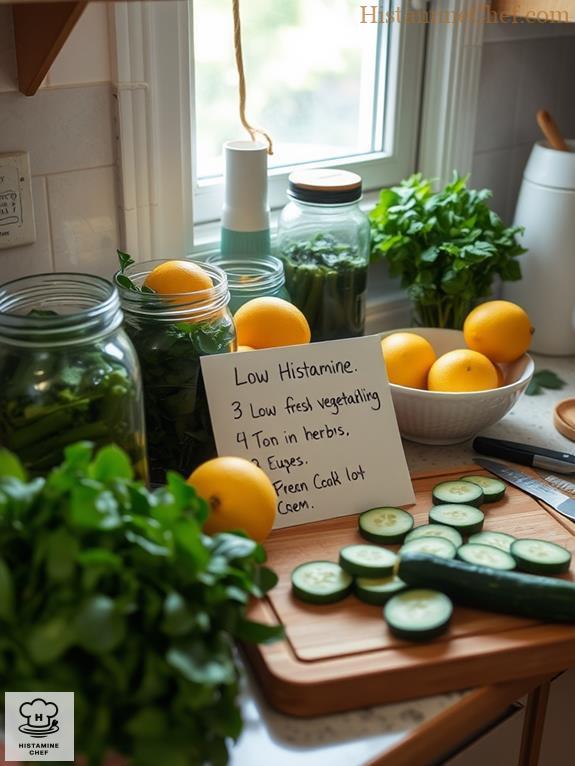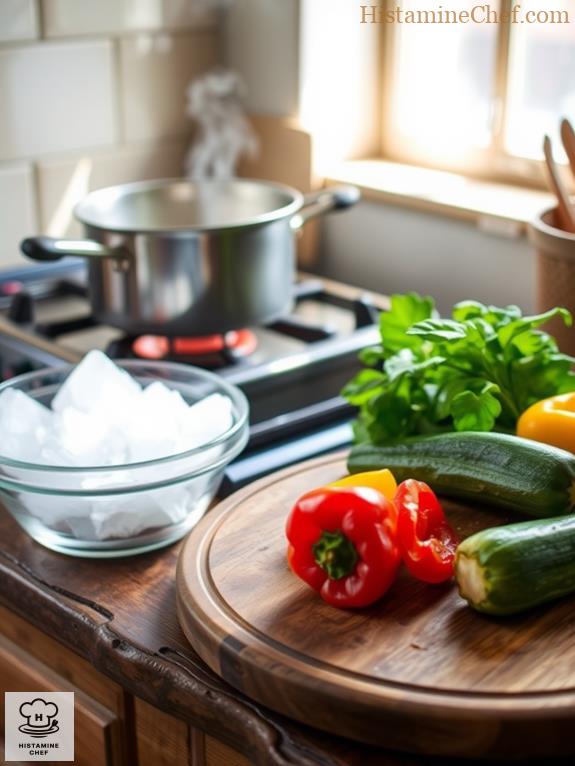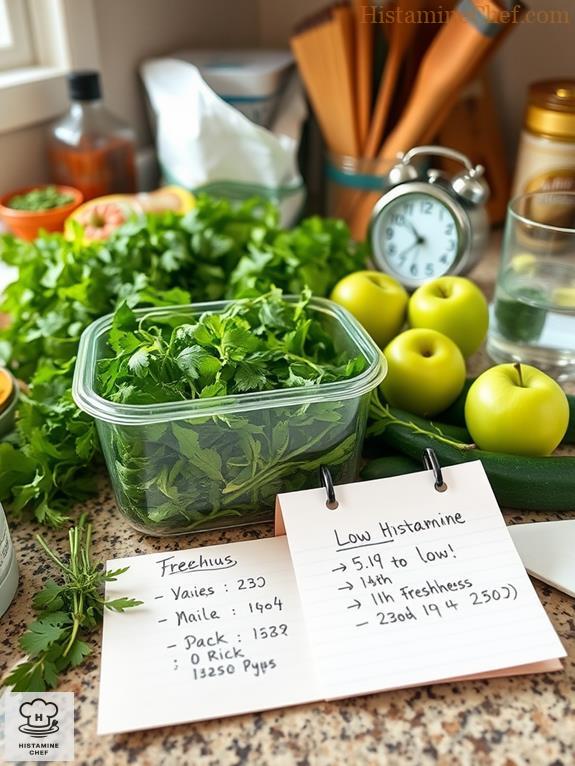Ever wondered how to keep your low-histamine foods fresh as a daisy? I’ve got you covered!
I learned the hard way when my bell peppers turned mushy overnight. Yuck! Now, I swear by vacuum sealing and freezing. It’s a game-changer!
I store everything in glass containers – no sketchy BPA for me. And let’s be real, who doesn’t love playing food detective? I’m always on the lookout for vibrant colors and firm textures.
Oh, and my SIGHI list? It’s my ride-or-die for dodging histamine bombs.
My Histamine Nightmare at the Farmers Market
Last summer, I hit the farmers market, feeling like a kid in a candy store. I loaded up on fresh produce, ready to meal prep like a boss.
But here’s the kicker: I forgot my cooler bag. By the time I got home, my veggies were wilted and sad. Talk about a histamine horror show!
That’s when I realized the importance of proper storage and quick freezing. Now, I’m the cooler bag queen, keeping those histamines at bay like a pro.
Key Takeaways
- Vacuum sealing helps prevent histamine buildup and maintains the freshness of low-histamine foods for longer periods.
- Freezing low-histamine vegetables, like bell peppers, locks in freshness and prevents spoilage.
- Store vegetables in airtight, glass or BPA-free plastic containers to keep moisture and air out.
- Monitor food freshness by checking for vibrant colors and firm textures, discarding any mushy fruits or veggies.
- Utilize proper storage techniques, like keeping potatoes in a dark place, to prevent sprouting and maintain quality.
Understanding Low-Histamine Foods

I often find that understanding low-histamine foods is essential for anyone dealing with histamine intolerance.
It’s like discovering a secret garden of flavors that won’t leave you feeling bloated or uncomfortable.
Mastering food labels is vital for identifying hidden histamines and making informed choices when shopping for low-histamine options.
Low histamine vegetables like bell peppers, carrots, and zucchini are your tasty allies.
And when it comes to low histamine fruits, think apples, blueberries, and cherries.
These vibrant options add color and life to your plate without the histamine drama!
Have you ever bitten into a juicy peach, only to regret it later?
Avoid that heartbreak!
Stick to the SIGHI list for guidance, and you’ll navigate this culinary adventure with ease.
I write this blog, Histamine Chef, to help you savor life without the histamine hassle.
Let’s explore together!
Effective Storage Techniques

Storing low-histamine foods effectively is essential for maintaining their freshness and preventing histamine buildup. Have you ever opened your fridge to find wilted greens or sad-looking fruit? That won’t happen if you use vacuum sealing! This technique removes air, keeping your veggies crisp and your fruits juicy.
Smart food storage techniques are vital for those following a histamine-friendly diet, as they help minimize histamine formation in foods over time.
I love experimenting with fermentation alternatives, like using rice vinegar instead of traditional ones. It’s a fun twist, and it fits my low-histamine diet perfectly!
Remember to keep your potatoes in a dark place to prevent sprouting. Trust me, no one wants sprouted potatoes at dinner!
Freezing Strategies for Freshness

Freezing is one of the best ways to lock in the freshness of low-histamine foods and prevent spoilage. Using versatile freezer-friendly containers can help maximize space and keep your foods organized.
These containers are perfect for storing pre-portioned meals or individual ingredients.
I love using freezing methods for my favorite low-histamine veggies like bell peppers and carrots. Just chop them up, spread them on a baking sheet, and freeze until solid.
This way, they keep that delightful crunch when you defrost them!
Now, let’s talk about food texture. Not every food freezes well, so you might want to avoid watery veggies like tomatoes.
When you pull them out, you’ll find a mushy mess!
Cooking Methods to Reduce Histamine

While freezing locks in the freshness of low-histamine foods, cooking methods also play a significant role in managing histamine levels.
I’ve found that low temperature cooking is a game-changer! When I prepare my meals at lower temperatures, it helps minimize histamine formation.
Think about it: quick preparation methods like sautéing fresh veggies or steaming fish can keep dishes vibrant and nutritious.
Slow-cooker meal prep is another excellent option for low-histamine cooking, allowing you to prepare meals in advance while maintaining lower temperatures.
Who doesn’t love a colorful plate of allowed veggies like blueberries and apples?
And hey, did you know that sticking to fresh, pure meats like chicken and duck can make a world of difference?
Choosing the Right Containers

When it comes to preserving the freshness of low-histamine foods, choosing the right containers is essential. Stylish glass containers can elevate your kitchen aesthetics while providing practical storage solutions for your low-histamine diet.
Four game-changing tips to contemplate:
- Container Materials: Opt for glass or BPA-free plastic to minimize chemical leaching.
- Airtight Seals: Make sure your containers have airtight seals to keep moisture and air out.
- Portion Sizes: Use containers that fit your meal portions to avoid waste—because who wants to toss out leftovers?
- Transparent Visibility: Choose clear containers for easy peeking—no more guessing what’s inside!
Stackable designs help save space, and label organization keeps everything tidy.
Trust me, with the right containers, your low-histamine foods will stay fresher, longer! Who doesn’t love a good meal without the histamine headache?
Monitoring Food Freshness

Maintaining freshness in low-histamine foods requires vigilance and attention. I often find myself peeking into my fridge like a detective hunting for clues! Understanding histamine-related disorders can help guide your food choices and storage practices.
Proper storage is essential for maintaining low histamine levels in foods. Food spoilage can sneak up on us, so I rely on freshness indicators. For veggies, look for vibrant colors and firm textures—if they start to wilt, they’re waving a little red flag.
Fruits should feel just right—no mushiness, please! And keep in mind, check expiration dates on all your ingredients. It’s like a treasure hunt for freshness!
Using the SIGHI list helps me dodge high-histamine pitfalls too.
FAQ
How Can I Tell if a Food Is High in Histamine?
To determine if a food’s high in histamine, I rely on histamine testing and explore various food sources. I experiment with my reactions, noting what works for me, and adjust my diet accordingly.
What Are the Symptoms of Histamine Intolerance?
You wouldn’t believe the chaos histamine symptoms can release! I’ve experienced wild food reactions like headaches, rashes, and digestive disasters. It’s a rollercoaster ride I wish I could get off—preferably at a low-histamine station!
Are There Specific Brands of Low-Histamine Products?
I’ve found some great brand recommendations for low-histamine products. While exploring product comparisons, I discovered innovative options that suit my needs perfectly. It’s exciting to see how brands cater to our dietary preferences!
Can I Consume Canned Low-Histamine Foods Safely?
Did you know that over 70% of people with histamine intolerance report reactions to canned foods? I find that canned options often have higher histamine levels, making fresh alternatives a safer, more innovative choice for my diet.
Is There a Low-Histamine Meal Prep Service Available?
I’ve researched meal prep service options for low-histamine diets and found some innovative choices. They cater specifically to our needs, ensuring fresh ingredients and delicious meals without triggering any histamine responses. It’s a game-changer!
Summary
I’ve discovered that preserving freshness is crucial for low-histamine eating. I use proper storage techniques, freezing methods, and creative approaches to keep my meals vibrant and delicious. These strategies help me maintain a diverse and enjoyable low-histamine diet while managing histamine intolerance.
What are your go-to methods for keeping low-histamine foods fresh? Share your experiences in the comments below. I’d love to hear about your innovative approaches and success stories.
If you found this information helpful, please share this post on your social media platforms. Your support helps Histamine Chef reach more people struggling with histamine intolerance, providing them with valuable insights and strategies.


Leave a Reply